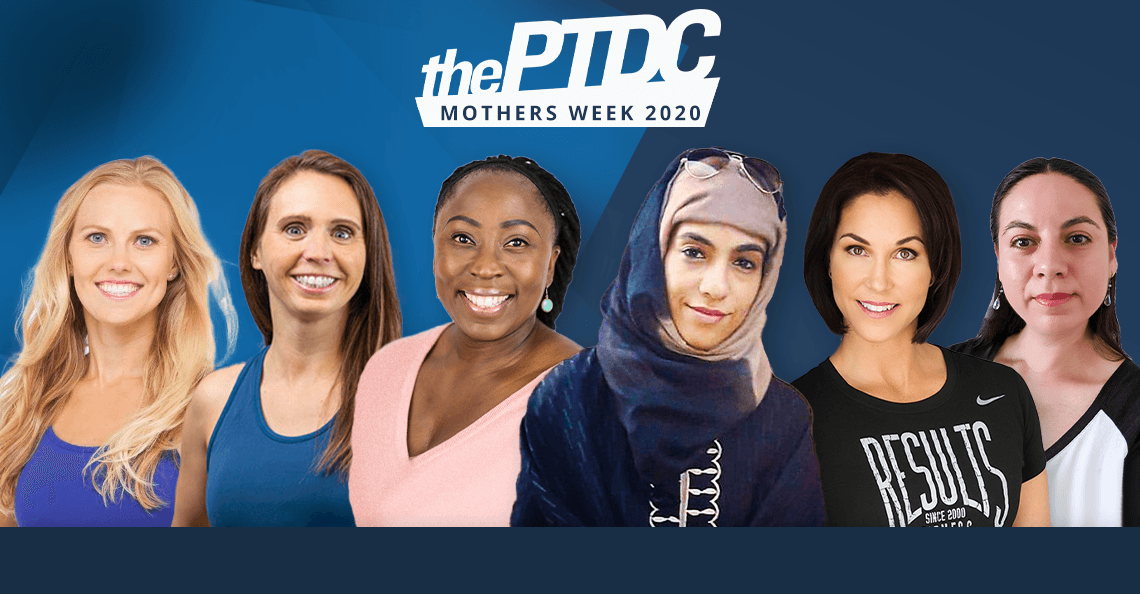“Once postpartum, always postpartum.”
A woman’s body begins to change the moment she conceives. She’s the baby’s only source of food, shelter, and comfort for the next 40 weeks. By the time she delivers, her body is changed forever.
If you’re a trainer or nutritionist who works with women, you need to understand what those changes are, and how they affect your female clients from pregnancy to menopause and beyond.
We asked six experts—Erica Ziel, Jenny Burrell, Sarah Ellis Duvall, Rachel Cosgrove, Yusra Es-Haq, and Lulu Flores—to help you navigate the challenges of coaching clients at every stage of motherhood, and to offer solutions.
Part 2: Nutrition for new moms
Part 4: Returning to serious training
Part 5: Emerging from the fog of motherhood
Part 7: Final thoughts on coaching mothers
Part 1: Pregnancy
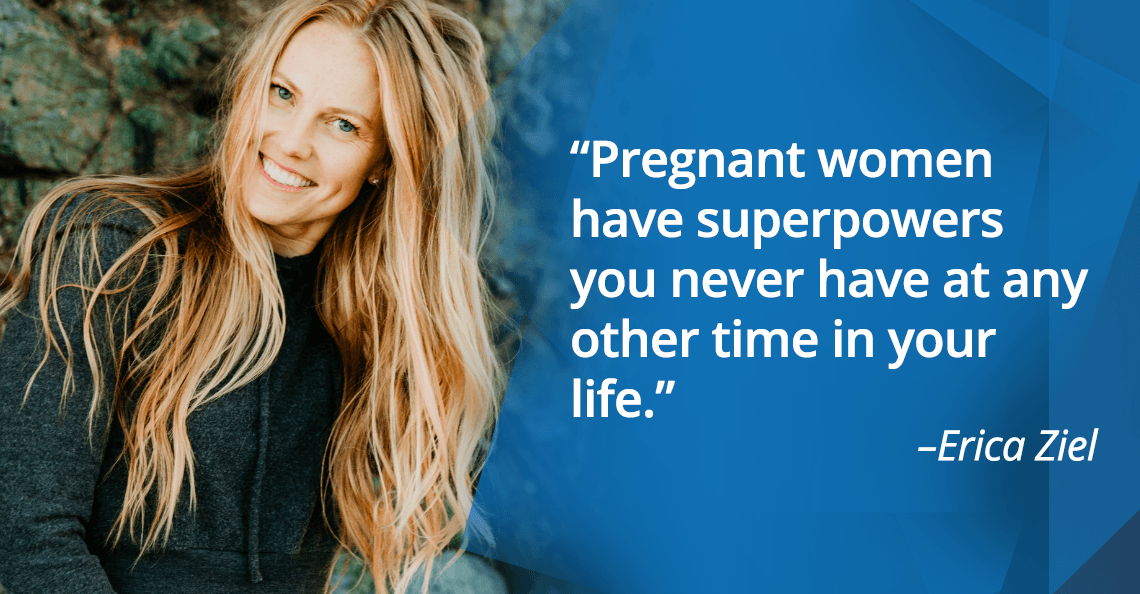
Pregnancy affects every aspect of your client’s physiology. Every organ, every system, every ligament.
Her metabolic rate increases and her heart pumps more blood. Most pregnant women experience nausea in the first trimester, which is probably the body’s way of warning her off foods that might damage the fetus.
By the final weeks of the pregnancy, the baby is pulling calcium from her bones and protein from her muscles. Her own body is running on a higher percentage of fat so more glucose can go to the baby.
Most trainers focus on the hormonal surges that increase joint laxity, particularly in the lower back and pelvis. Those changes are apparent almost immediately, especially if the client has given birth before, says Erica Ziel, a core exercise specialist, author of The Knocked-Up Fitness Guide to Pregnancy, and mother of three.
“You’ve got to be a little more cautious about keeping this client from injuring herself,” she says.
But increased laxity doesn’t always mean your client has increased ranges of motion.
“You get some who become more flexible, but also some who get tighter,” Ziel says. “I think it’s the body’s way of protecting itself from overstretching.” It’s up to the trainer to monitor the client’s movement quality, making sure she’s in control no matter her range of motion.
Another way pregnant clients differ:
“An athlete might need to do less exercise because she doesn’t have the energy,” Ziel explains. That client can easily become overtrained if she continues her normal routine throughout her pregnancy.
“But when you get a woman who was previously sedentary, she can become quite a bit stronger as her pregnancy progresses,” she adds, as long as you start slow and gradually increase volume and intensity.
Every pregnant client, Ziel says, “should always feel better after a workout than when she started. Exercise doesn’t have to be excessive to be effective. If she feels tired and depleted after a workout, we overexercised her, and that increases stress.”
The key is to ensure there’s a purpose to everything you do in the program, the most important of which is to prepare her body for pregnancy, birth, and recovery.
In particular, you should take advantage of what Ziel calls her “superpowers”: “From a core perspective, she has this amazing feedback to make these muscular and fascial connections she’ll never have at any other time.”
What’s not important, Ziel says, is how many calories she burns in your workouts. “We have to get her mind off the scale. If she’s fit and she’s smaller, she’s likely to gain more weight, because she needs it.”
But, like everything else when it comes to motherhood, there’s nothing simple about pre- or postnatal nutrition and weight changes.
Part 2: Nutrition for new moms
Nutrition guidelines for pregnant and lactating women are relatively straightforward, says Yusra Es-Haq, a Level 1 Certified Online Trainer, nutrition coach, and mother of four who has multiple certifications in pre- and postnatal exercise:
- First trimester: no additional calories needed
- Second trimester: 300 to 340 additional calories
- Third trimester: 450 additional calories
- Breastfeeding: about 500 additional calories
But that doesn’t mean you should encourage a pregnant or breastfeeding client to count calories. “It’s added stress that a mama doesn’t need,” she says.
Coaches should instead focus on “building healthy nutrition and self-care habits they can practice postpartum, like consuming high-quality nourishing foods, eating slowly, listening to their body’s hunger and satiety cues, and resting as much as possible.”
Which would be wonderful if all your clients lived in a world where they can focus on themselves.
“Many mothers with newborns do not have a social or family support network,” says Lulu Flores, a nutritionist, certified lactation educator, and mother of one. “They’re alone with the baby at home—and, on many occasions, other young children.”
The consequences of that isolation—combined with stress, fatigue, and sleep deprivation—can go in two extreme directions, she adds: “Some mothers finish the day having eaten almost nothing, and some eat what they can, when they can.”
In Flores’ experience, many of them end up gorging on packaged baked goods. They’re easy to consume with one hand while holding a screaming baby and require no preparation or cleanup.
Another challenge: When pregnant or nursing women do focus on themselves, it’s often in unhealthy ways, Flores says:
- Fear of excess weight gain leads some pregnant women to restrict calories. Sometimes that fear is reinforced by trainers and nutritionists giving them targets for daily calories and overall weight increases.
- Lots of new mothers feel an urgency to drop their baby weight, with a few turning to crash diets.
If you think your client is going down a risky path with her diet, the best tactic is to show you care.
“You have to have a lot of empathy,” Flores says. “Let the mother know what the current recommendations are without making her feel judged, or that you despise her beliefs.”
Part 3: Postpartum recovery
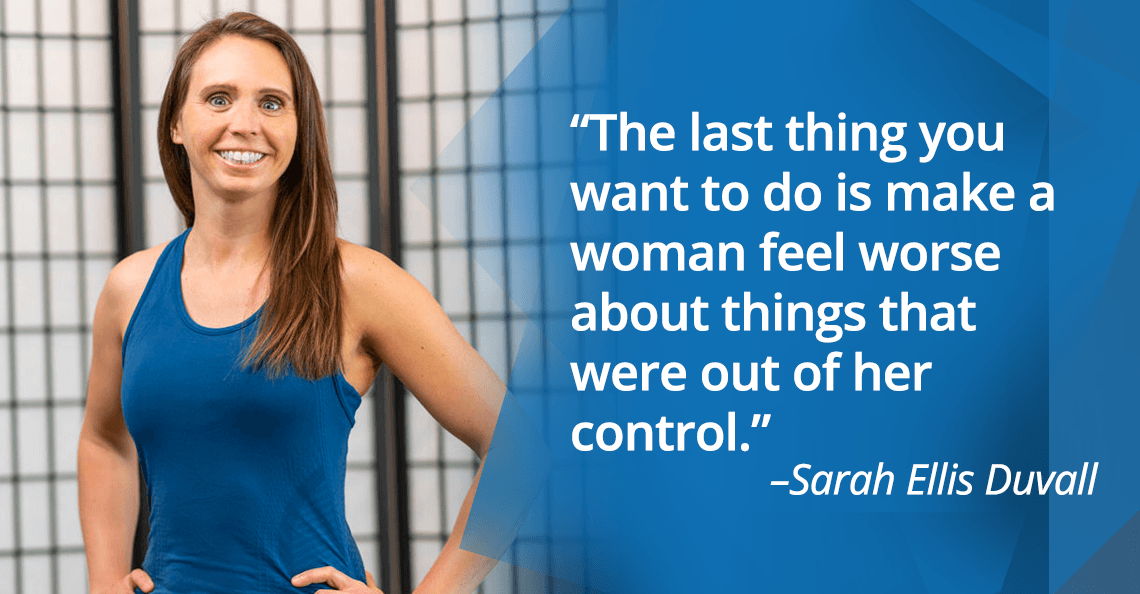
Your client has recently delivered her baby, and she’s ready to start training again. Kind of.
If she had a C-section, she’s recovering from a surgery that penetrated her skin, muscles, and connective tissues to reach into the uterus and pull the baby out.
If she had a vaginal delivery, she probably experienced some degree of tearing along her perineum. It’s typically worse for first-time moms, those who have larger babies, and those whose delivery involved forceps or a vacuum.
And no matter the type of delivery, she almost certainly has some amount of diastasis recti, a stretching and weakening of the linea alba, turning her six-pack muscle into a couple of three-packs.
“Diastasis is normal,” says Sarah Ellis Duvall, DPT, a physical therapist, mother of two, and creator of the Pregnancy and Postpartum Corrective Exercise Specialist certification. The severity is partly genetic, and partly due to how she trained—or didn’t train—during pregnancy.
To avoid making it worse, you have to know what to look out for, and use appropriate precautions, as explained in this article on training new moms.
Incontinence, though, is not normal. “Incontinence should be a wake-up call for women, especially younger women,” Ziel says. If your client is peeing every time she runs, jumps, or even laughs, it’s a sign of pelvic floor dysfunction. “Those muscles are either too tight or too weak, or a combination of both.”
But it’s not just the core and pelvic floor. “Diastasis is a full-body issue,” Duvall says. “It’s how you move, breathe, and load your body. The whole kinetic chain matters.”
Makes sense, right? That’s why, if you train clients in person, you probably use a movement screen, postural assessment, or both. And whether you train them in person or online, you surely focus on their exercise form.
But even then, things can go wrong. No matter how diligent you are with a pregnant client, or how cautious you are in your postpartum workouts, she may still end up with severe diastasis recti—or, worse, pelvic organ prolapse, when her bladder or rectum literally falls down into her vagina.
“It’s emotionally crushing,” Duvall says. “It’s your very sense of who you are.”
She speaks from personal experience.
Part 4: Returning to serious training
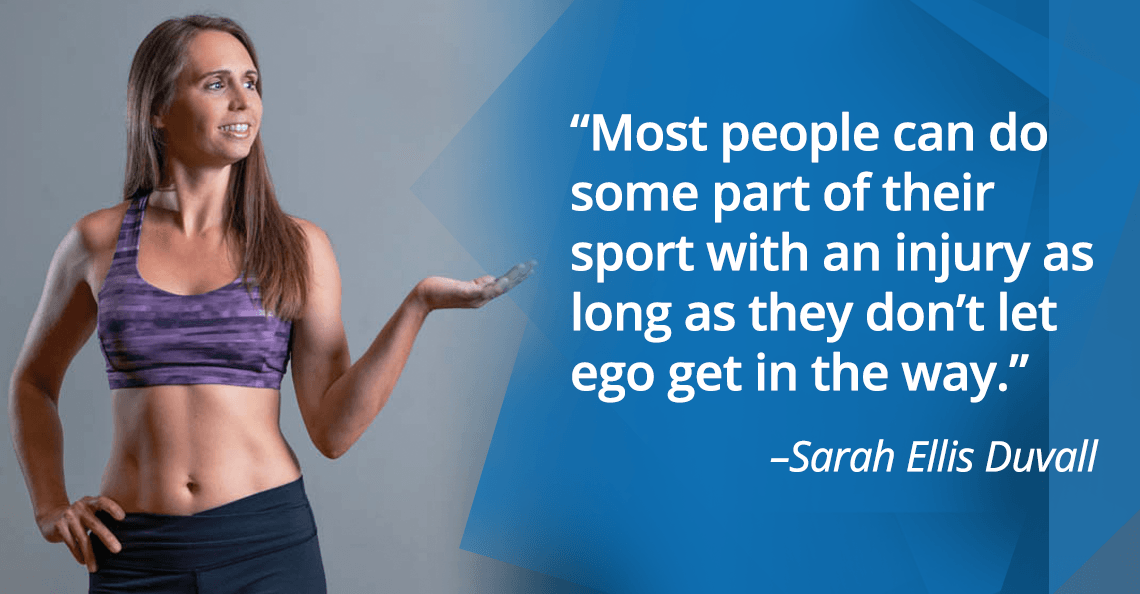
Duvall has been a dedicated athlete her entire life, with a string of injuries almost as long as the list of sports she’s pursued.
That’s on top of her professional knowledge and experience as a physical therapist. Her doctoral project focused on the pelvis. And she still developed a prolapse after the birth of her second child.
“Nobody thinks it’s going to happen to them, until it happens,” she says. “Prolapse made me respect my body a lot more. Every injury teaches you something, and I like to learn the hard way.”
The problem begins when the pregnancy and delivery stretch out the tissues of the pelvic floor. But then it’s exacerbated by the way a new mom puts pressure on those tissues.
“People bear down to get the last rep,” she explains. “When it comes from the wrong place, it can make prolapse worse. It can make diastasis worse. Some people just have patterns of movement that inherently create pressure out or down. It’s hard to use the right mechanics when you don’t have the patterns in the right place.”
Duvall was one of those people, and had to learn how to do everything again, despite a lifetime of training and competing at a high level.
Athletes and fitness enthusiasts like her are often the highest-risk postpartum clients. They want to get right back to where they were. Ironically, she says, “it’s easier to work with someone who was on bedrest. They’re out of shape and feel out of shape. They’re more willing to start with the basics.”
With any postpartum client—whether they feel strong, weak, or anything in between—you need to identify their weakest link and design the program to address it, rather than building the workout around what the client can get away with it.
It’s the trainer’s job to find those weak links, and do it in a way that shows the client where she’s vulnerable. These are the tests Duvall uses:
1. Breathing pattern
Does she breathe into her belly? If she does, that’s a pretty good sign she’ll put pressure on her most vulnerable tissues if she tries to move a heavy load.
What you want to see, Duvall says, is a 360-degree breathing pattern:
- Have your client sit upright on a chair or bench.
- When she breathes in through her nose, her torso should expand in all directions—front, sides, back.
- When she exhales through her mouth, her entire abdominal wall should flatten, not bulge.
2. Dead bug
“Can they stabilize their spine and pelvis,” Duvall asks, “or do they shift all over the place?”
And when they stabilize, can they breathe while maintaining a braced core?
3. Hip hinge
Duvall wants to see if the client can maintain a neutral lumbar position during a hip hinge, which requires eccentrically lengthening her glutes. If she needs to hyperextend her lumbar spine to bend forward, work on that before loading any hip extension exercise.
Also see if she can brace her core and control her hips. If her stomach bulges out, or if her hips move laterally, spend more time on stability work before jumping into deadlifts and squats.
4. Push-up
“I don't assess a push-up in everyone because it's hard,” Duvall says. But if the client passed the first three tests (and if you assessed her for diastasis recti, as shown in this video by Jessie Mundell), see how she does in the push-up position.
Can she load her core while continuing to breathe? As she lowers her body toward the floor, can she hold an abdominal brace?
What about her shoulder blades? Can she control them, or do they look like they’re trying to fly away?
5. Landing and loading
The final test, for a client who wants to return to high-level training, is “to see what happens dynamically at their hip, knee and foot when they land or load,” Duvall says.
If they can control those joints during a squat, kettlebell swing, or depth jump from a low box or step, they’re cleared for takeoff.
Part 5: Emerging from the fog of motherhood
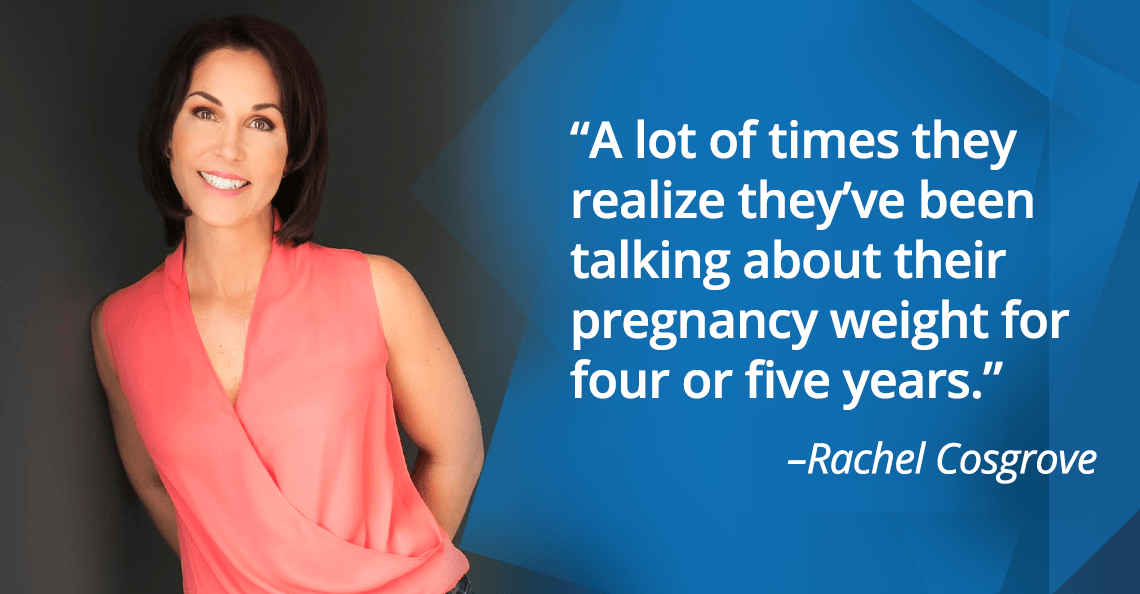
Not every new mom gets right back to the gym. For some, it’s just not feasible. Many return to work soon after giving birth, and it might be years before they can squeeze a workout program into their schedule.
When they do come back, they’re most likely to do it at one specific time of the year:
“For us, September is like January,” says Rachel Cosgrove, co-owner of Results Fitness in Santa Clarita, California, and Results Fitness University, a coaching business for gym owners. “The kids are back in school, and they can start putting themselves first again. The mom’s like, ‘I have a few hours here. I can do this.’”
Those moms present unique challenges for coaches:
1. They’re deconditioned, but they’re not all deconditioned in the same way
Some have maintained a high activity level from keeping up with their kids. Others have been mostly sedentary.
Some are former athletes or gym rats who want to get back into what they were doing before. Others had never been in shape, and still have pregnancy- and delivery-related injuries like diastasis recti or prolapse to work around.
And if you do a postural evaluation before you start training, you’ll often see imbalances caused by holding their kid on one hip—usually on their dominant side—while they multitask, Cosgrove says.
They also have two things in common:
- “They’re obviously motivated to get back in shape,” Cosgrove says. “They’ve gotten to a point where they’re tired of feeling the way they feel, and they want to do something.”
- They can’t activate deep muscles in their core and pelvic floor. “The nervous system doesn’t know how to switch them on anymore,” she says. “You have to wake those muscles up again.”
2. Many have used crash diets
“If they’ve tried to lose weight after pregnancy, a super-low-calorie plan seems to be the default,” Cosgrove laments. “The older they are, the more likely it is they’ve done that multiple times.”
You know how those diets are most likely to work out for your clients:
- They lose weight fast, much of it from lean mass.
- They regain the weight they lost, plus a few more.
- They end up heavier than when they started, with less metabolically potent muscle tissue and a higher body-fat percentage.
That leads to perhaps the biggest challenge for a trainer working with these women: They measure progress with a scale. If it’s not going down, they assume the program isn’t working.
“Because they’ve had success with that diet in the past, even though it didn’t last, they think they have to do it again,” Cosgrove says. “We have to convince them to be consistent, fuel their body, and do strength training to build back their muscle while using a different form of measurement than the scale. And if they do those things, they won’t ever have to do a crash diet again.”
Part 6: Menopause and beyond
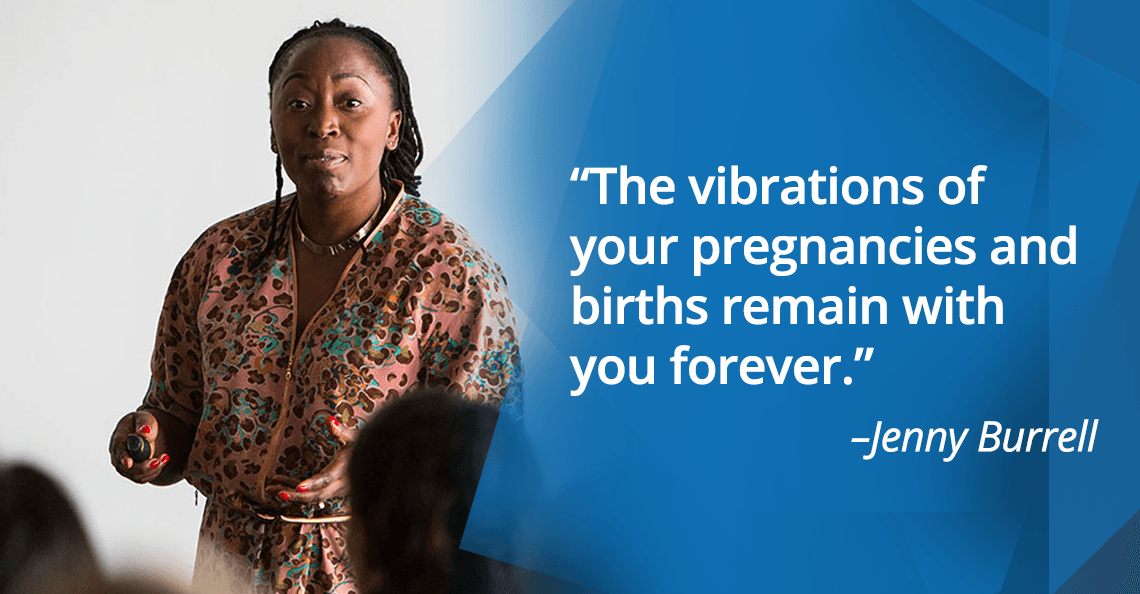
You might think that the pre- and postnatal issues we’ve talked about so far no longer apply to women as they enter menopause. Mild forms of diastasis recti and prolapse typically resolve themselves within a year of giving birth, while more serious conditions have probably been addressed through physical therapy, if not surgery.
But you’d be wrong.
“For so many women the physiological legacy of their birthing years really do become apparent as they head to menopause,” says Jenny Burrell, founder of Burrell Education, whose education programs include a certification in peri- to postmenopause coaching.
The problem, she explains, is the decline in estrogen, which reduces the production of collagen by about 30 percent in the first five years of menopause. That, in turn, lowers both the quality and quantity of the connective tissues that hold their pelvic organs in place.
That's why the risk of prolapse rises among postmenopausal women, including about 50 percent of those who've given birth. The drop in estrogen also leaves them metabolically wired to add visceral fat, while the loss of collagen makes it harder to build or maintain muscle tissue.
“This is also a time when women in general start moving less and eating and drinking more, both of which are really the opposite of what their bodies need,” Burrell says.
For those reasons, Burrell says two practices are non-negotiable for any coach who works with late-middle-aged women:
- A detailed health and movement screen, including an assessment of pelvic floor function
- A fully customized training program
Burrell uses herself as an example: “Although I'm a mother, I've never given birth. But if you screened me, I'd tell you that I have pelvic health issues usually associated with birthing.”
She’s had multiple surgeries, including a hysterectomy. That leaves her with significant complications and challenges:
- “Hysterectomized women have an increased rate of pelvic organ prolapse,” she says. “So I avoid the exercises that I know make me symptomatic—running, skipping, and ballistic jumping.”
- Her post-surgery scar tissue and adhesions necessitate a lot of mobility and soft-tissue work, which make up nearly half her workouts. This applies to any clients who’ve found themselves supine in an operating room, but will be more prevalent among your older moms.
- The prolapse risk limits how much weight she can train with. “I look strong and probably could go heavier,” she says. “But will 80-year-old me thank me for that?”
That last question is an example of the “could/should math” every trainer has to do with every client in this demographic.
“We need to stop with the ‘beasting’ message,” Burrell says. “More exercise alone isn't the fix. It's hugely valuable and relevant to address their mental well-being, not just their physical well-being.”
Lots of women in this stage of life are what Burrell calls “the meat in the sandwich”—taking care of their parents while also helping their kids. “Women at this time are generally time-poor and exhausted,” she adds. “Whatever programming you create for them has to be sympathetic to the reality of their lives.”
And here’s a radical thought: Even though they come to you for fitness training, what they need most may be lifestyle coaching, Burrell says. Or just to be heard.
Part 7: Final thoughts about training new moms
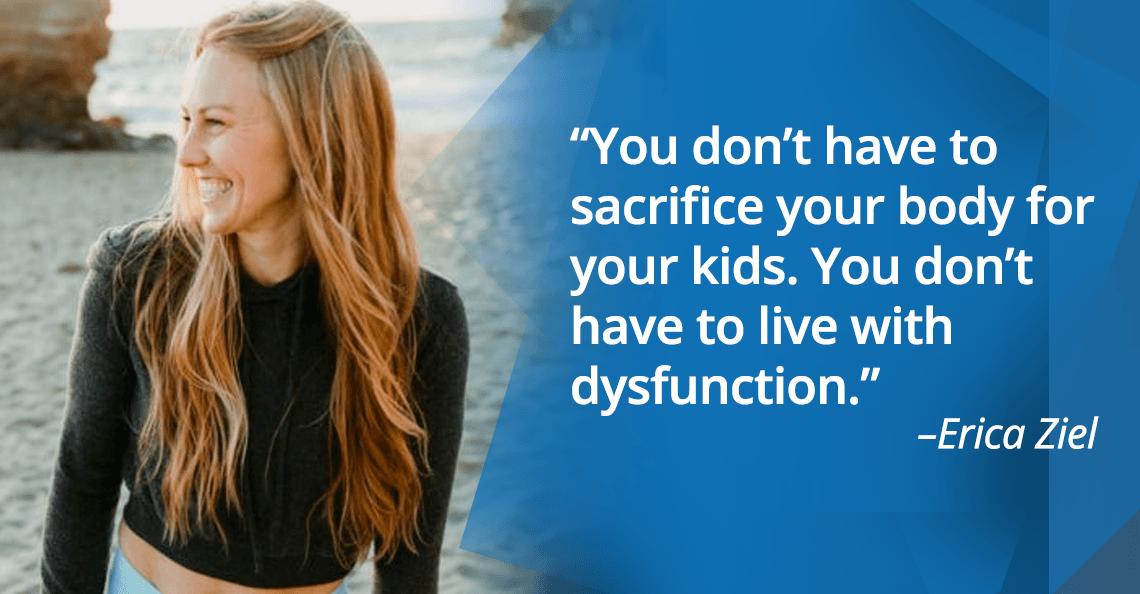
If we had to summarize what we just learned from our six experts on training and feeding mothers, it might be something like this:
- Address each client’s issues as thoroughly as you can, as early as you can. Every injury, complication, or dysfunction you address now will help your client enjoy a healthier, more active life for years down the road.
- You can’t help your client unless you listen to her, and meet her where she is, rather than where you think she should be.
“We need to work with the person in front of us,” rather than viewing them through the filter of our own preferences and biases, Es-Haq says.
“Pre- and postnatal women are more than a collection of muscles, tissues, bones, and tendons. They’re individuals with goals, hopes, dreams, beliefs, and history, and as trainers we need to acknowledge that. We need to help them in a way that serves them, not a way that suits us.”
So even though you’re helping them through the awesome and difficult process of creating and nurturing life, you’re also on a journey of your own.
“We shouldn’t be afraid to ask questions,” she says. “We shouldn’t be afraid to be wrong and admit it. Growth comes from a place of discomfort and uncertainty. That's how we get better at what we do, and that’s how we serve and empower our clients.”
Are you a mom who wants to coach moms online?
You are? That's awesome.
So how do you turn that aspiration into a business? How do you coach clients with all the chaos and interruptions of family life?
At the Online Trainer Academy, we understand how challenging it is to launch and run a coaching business, especially when you're a mom with kids at home. We've been helping personal trainers and nutritionists just like you since 2013.
As an Online Trainer Academy Level 1-certified coach, you can confidently and successfully coach the clients you want, on a schedule that works for you, from wherever you happen to be.
Do you have to work around your baby's naps and feeding schedule? Your online clients will never know if you write their programs in the middle of the night. Nor will they care.
Do you need to relocate for your spouse's job or a family emergency? Your online clients travel with you.
For as little as $87 a month, you can learn the business of online coaching. Not just how to write programs, but how to become the obvious choice for the clients you want to work with, and how to create systems to find, coach, and retain those clients.
What's more, it's guaranteed. If you don't add $1,000 a month to your bottom line within 90 days of earning your Online Trainer Academy Level 1 certification, you get your money back.
Consider it an early Mother's Day gift to yourself.


